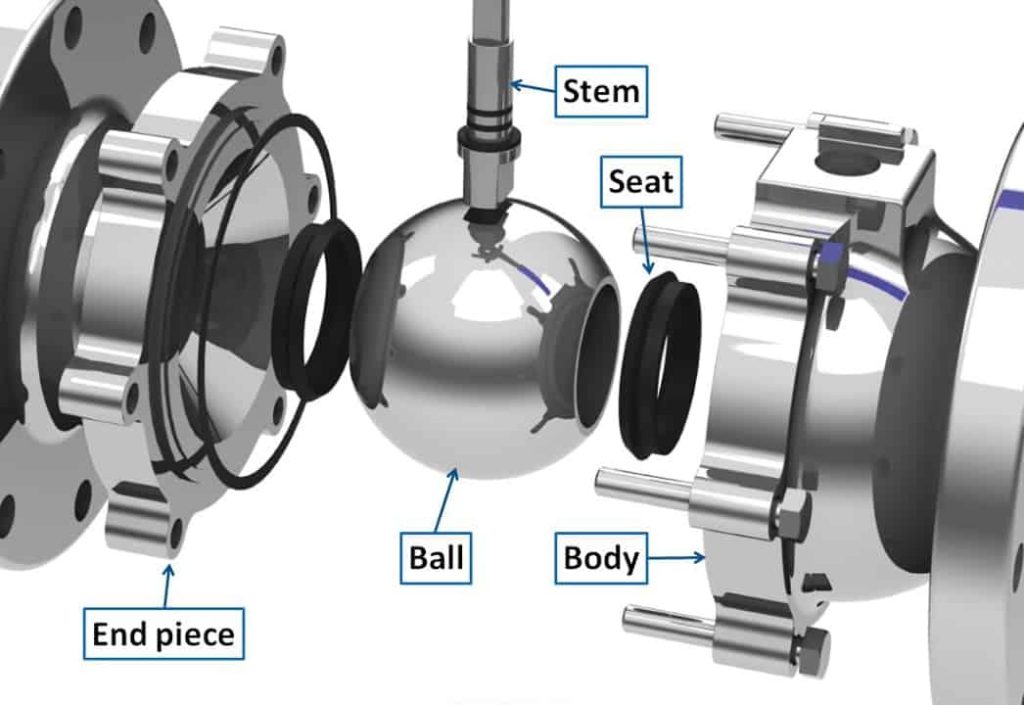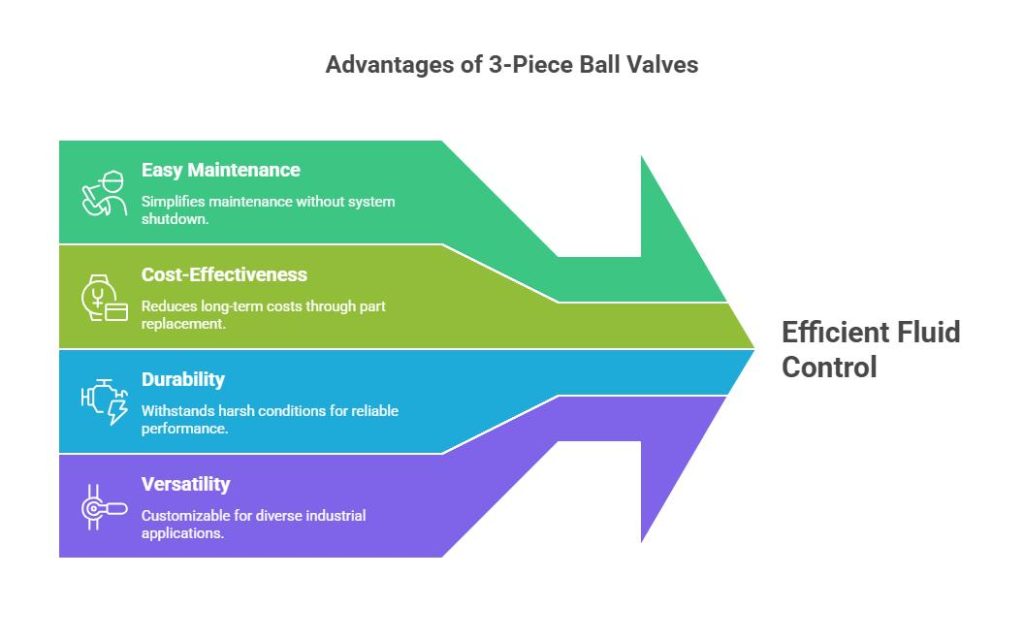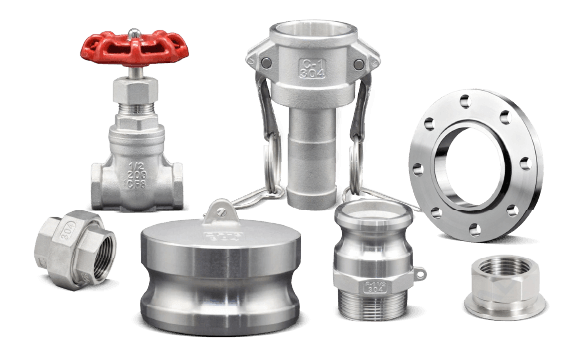

3-piece ball valve selection can greatly influence productivity and downtime in an industrial and maintenance environment. Of the various valve types, 3-piece ball valves are special because of their unique construction and many advantages. Known for their durability, ease of maintenance, and dependable service, they are used across many applications in industry, including oil and gas, chemical manufacturing and processing, pharmaceuticals, and food manufacturing.
When unexpected valve failures cause costly production halts, how confident are you in your choice of valve technology? This article will discuss what makes 3 piece ball valves unique, their components, and how the ease of their maintenance has made them the preferred solution for such applications.
EN 3-piece stainless ball valve is a valve that consists of three major components: the central valve body and two end caps (or pipe connectors). The three-piece design allows the valve to control fluid flow by turning a ball with a bore through its centre, allowing the bore to align with the pipeline to allow flow, or to turn perpendicular to the fluid to stop it.

The three pieces mean the valve body is removable from all the pipeline and fittings needed to support and install the valve system, allowing the valve to be maintained and repaired.
3-piece ball valves are distinct due to their modular design. This allows a technician to service internal components such as seals or the ball without cutting the valve away from the pipeline, allowing maximum downtime reduction. This design is preferable for those processes that require routine cleaning or must stay operational during maintenance and servicing.
Due to their versatility and suitability for high-pressure, high-temperature, or challenging environments, three-piece valves can serve in many chemical plants, food processing, and oil & gas pipeline services.

The main components include:
The primary advantage of a 3-piece ball valve is easy maintenance. Because the valve body can be detached without removing the entire valve from the line, technicians can clean or replace internal parts in place. This design is particularly beneficial in industries that require frequent sanitation, such as pharmaceuticals, food and beverage, and brewing.

Additionally, inspecting the ball and seals directly helps prevent unplanned shutdowns and ensures consistent performance. This enhances system reliability and lowers labour and replacement costs over time.
3-piece ball valves offer several compelling advantages, making them the go-to choice for many industrial applications. From ease of maintenance to long-term cost savings, here's why they stand out in fluid control systems:

One of the biggest advantages of 3-piece ball valves is simple maintenance and cleaning. The three-piece construction can detach the central body without breaking the end connections and surrounding piping. This means that internal elements, such as seals, seats, and the ball, can be cleaned or replaced without the need to shut down the entire system.
This accessibility to cleaning equipment is particularly advantageous for businesses sensitive to sterilization protocols, like food manufacturing or pharmaceuticals.
While 3-piece ball valves may have a higher purchase cost than one- or two-piece, they tend to be more cost-effective and sensible sunk costs over time. A 3-piece ball valve design allows for parts to be replaced individually rather than replacing the entire valve assembly. This will save on materials and labour costs.
Further, not having to shut down operations for a full valve replacement saves you time and money on operational costs, and should be regarded as a benefit in the value proposition. These valves are sensible investments and especially appealing for systems that require longevity and uptime.
The design of 3-piece ball valves allows for high performance under high pressures, extreme temperatures, and corrosive environments. They are made of strong alloys, often stainless steel, or a mixture of alloys. Because of their design and materials, they are more corrosion-resistant and allow for a longer component life.
Therefore, they are a reliable and safe option in hostile environments and applications, including oil and gas, chemicals, and marine operations.
By design, 3-piece ball valves provide expanded adaptability and configurability. Available in various sizes, materials (corrosion-resistant alloys), pressure ratings, and many different end connections (weld, flanged, threaded, etc.), an engineer can precisely engineer the component to the unique system requirements.
Additionally, they can be automated with pneumatically or electrically driven actuators, and can work in manual and remote automated operations.

Thanks to their durability, modular construction, and ease of maintenance, 3-piece ball valves are widely used across various industries. Below are some of the most common and critical sectors that rely on these valves for efficient, reliable fluid control:
Equipment is subjected to intense pressure, extreme temperature, and corrosive fluids throughout the oil and gas industry. 3-piece ball valves are commonly used because they can be removed easily and repaired or inspected in line. This minimizes the impact on productivity during events such as pipeline pigging, sampling, and flush operations.
3-piece ball valves are also a great choice for upstream, midstream, and downstream applications because of their high-quality stainless steel bodies and the capability to seal tightly.
The chemical industry includes various aggressive and hazardous processes and constantly needs valves with great chemical resistance properties, reliable zero leakage, and leaks. 3-piece ball valves are a good option, made with durable materials such as stainless steel, PTFE seats, and Viton seals.
3-piece ball valves can also be easily disassembled, allowing quick cleaning and inspection. Combining effective maintenance with product integrity and process safety is essential in the chemical industry.
Creating hygienic and sanitary conditions when preparing food and beverages is paramount in manufacturing. 3-piece ball valves are essential because they accommodate Clean-In-Place (CIP) and Steam-In-Place (SIP) processes.
The valves do not have crevices, and the internal design allows sanitization without removing them from the line. Due to these excellent characteristics, 3-piece ball valves often find their use on dairy process lines, brewing, beverage, and bottling process lines.
High sanitary standards and tightly controlled conditions are absolute requirements when producing pharmaceuticals. In these environments, 3-piece ball valves, especially the sanitary versions (3A, FDA etc.) have the capability to adequately sterilize systems and provide constant product quality.
Their modular capabilities allow for quick and thorough cleaning between batches, which is critically needed in multi-product environments.
Within municipal and industrial systems used to treat water, 3-piece ball valves control water flows, chemical additions, and filtration processes. Their corrosion-resistant characteristics, especially in chlorinated or treated water applications, will provide a long life for indoor applications.
Their design will also allow routine maintenance and repairs in remote and inaccessible areas, and less downtime for the system.
Electricity generation and HVAC (Heating, Ventilation, and Air Conditioning) systems require dependable valve solutions to control steam, water, and coolant lines. 3-piece ball valves can withstand the high temperature and pressure conditions necessary for those applications.
Their flexibility allows use in everything from complete high-pressure steam lines to low-pressure chilled water systems, supporting energy efficiency, safety, and overall reliability.
When choosing the right valve for an industrial system, understanding how 3-piece ball valves stack up against other common types is essential. Below is a comparison highlighting their performance, functionality, and advantages over gate and butterfly valves.
| Aspect | 3-Piece Ball Valves | Skydeventiler | Butterflyventiler |
| Design & Construction | Three-piece modular design with removable body for easy maintenance and repair. | The solid wedge gate moves up/down to open or close the flow; it has a multi-turn operation. | Rotating disc inside the valve body; quarter-turn operation, but with a different sealing mechanism. |
| Driftshastighed | Quick quarter-turn (90°) operation for fast opening/closing. | Slow multi-turn operation, requiring several turns to open/close fully. | Also, quarter-turn, fast operation, but less tight sealing than ball valves. |
| Opretholdelse | Easy maintenance: internal parts can be replaced without removing the valve from the pipeline. | Generally requires more maintenance; harder to repair without removal. | Maintenance can be simpler than gate valves, but sealing parts may wear faster. |
| Forseglingsevne | Excellent sealing with minimal leakage, even under high pressure. | Less reliable sealing over time due to wear on the gate and seat. | Moderate sealing; not as tight as ball valves, especially under high pressure. |
| Flow Efficiency | Full port design allows minimal pressure drop and turbulence. | The gate is fully out of the flow path when open, with minimal obstruction but slower operation. | Lower flow capacity due to disc obstruction; suitable for throttling. |
| Holdbarhed | Highly durable, resistant to corrosion and wear; suitable for harsh environments. | Less durable, prone to stem corrosion and wear. | Moderate durability; depends on materials used. |
| Koste | Higher upfront cost, but cost-effective over time due to ease of maintenance. | Generally, there is a lower initial cost but potentially higher maintenance costs. | Usually cost-effective but may require more frequent replacement. |
| Typical Applications | Ideal for high-cycle, high-pressure industrial use requiring frequent operation and maintenance. | Best for applications with infrequent operation and gradual flow control. | Common in HVAC and low-pressure systems where throttling is needed. |

3-piece ball valves are considered superior in many industrial applications due to their:

Selecting the right 3-piece ball valve for your system isn't just about price; it's about ensuring compatibility, durability, and performance under specific operating conditions. Here are the most important factors to consider:
Select the valve materials based on the fluid type and application.
Ensure the valve is rated for your system's maximum operating pressure and temperature.
Look for:
Select end types based on how the valve will be installed:
A major benefit of 3-piece valves is their serviceability. Choose a design that allows:
If your system requires remote operation, select a valve with a mounting pad (ISO 5211 standard) for actuators.
This makes it easy to install electric or pneumatic actuators for process automation.
For regulated industries (like food, pharma, or water treatment), look for valves that meet:
Buy from a reputable manufacturer known for quality and after-sales support.
Check if they offer:
3-piece ball valves are one of the best choices for any industry that uses ball valves and is looking for efficiency, reliability, and ease of maintenance. Their modulated design means they can be disassembled quickly to make cleaning and repairs much easier and economical, especially on a system where regular servicing is required or when it deals with harsh environments.
If you're moving towards an upgrade on a pre-existing system or want to design a new one, investing in quality 3-piece ball valves could improve your operational efficiency and reduce downtime.
EN: 3-piece ball valves are available in a wide range of sizes, typically from ¼ inch to several inches in diameter, depending on the manufacturer and application requirements.
EN: Yes. Most 3-piece ball valves have an ISO 5211 mounting pad for attaching pneumatic or electric actuators, making them suitable for automated or remote-controlled systems.
EN: Maintenance is straightforward: shut down the line, remove the center body of the valve, and inspect or replace the ball, seats, and seals as needed. This can be done without cutting or disturbing the pipeline.
EN: Many 3-piece ball valves—especially those made from stainless steel—are rated for high-pressure and high-temperature applications. Always check the manufacturer's specifications for exact limits.
EN: Unlike 1-piece and 2-piece valves, a 3-piece ball valve has a modular design with two end caps and a detachable center body. This allows for easy disassembly and maintenance without removing the valve from the pipeline.
